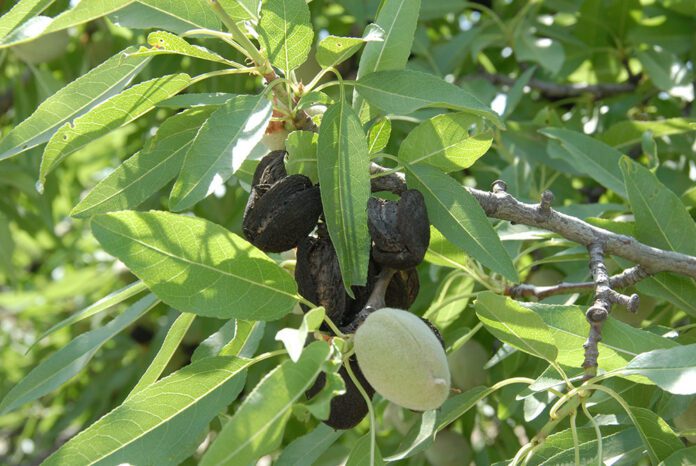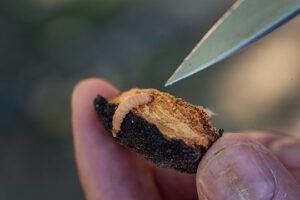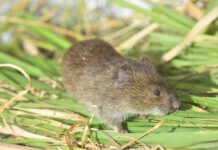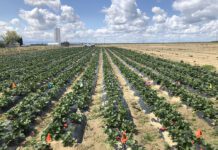
Listen to the audio version of this article. (Generated by A.I.)
Integrated pest management, or IPM, is a system that growers are encouraged to use to solve pest problems in their crops while being cost-effective and minimizing risks to people and the environment.
Using this approach, orchards and fields are monitored for insect pests or problematic weed infestations. Correct identification of the insect or weed and consideration of biological factors is necessary for making control or noncontrol decisions.
IPM programs combine management approaches for greater effectiveness. Economic thresholds have been the cornerstone of IPM since development of the concept.
In a recent UC webinar, Neil McRoberts, UC IPM affiliate advisor in the Plant Pathology Department at UC Davis, explained the basic ideas behind the use of IPM thresholds to make decisions on pest control.
“Decision thresholds are an important component of IPM and have been for as long as the IPM has existed,” McRoberts said. While IPM is a strategy that focuses on controlling pests and crop damage, it calls for a combination of techniques including biological control, habitat manipulation, modification of cultural practices and use of resistant plant varieties in addition to pesticide use. Ideally, pest control strategies are selected and applied in a manner that minimizes risks to human health, beneficial and nontarget organisms, and the environment.
McRoberts noted the history of IPM, citing a 1959 article in the publication Hilgardia where the basic concepts of IPM and the use of economic thresholds and economic injury levels in pest management were explored. The publication no longer exists, but McRoberts called it the precursor to what today is called California Agriculture.
Central concepts from the 1959 article describe economic damage as the level of damage, due to an insect pest, which justifies management actions specifically aimed at reducing pest impacts. Economic injury level is described as the pest population size or level of pest activity that corresponds to economic damage. The economic threshold is the pest population size at which intervention is triggered to prevent the pest from reaching the economic injury level.
“Over time, we have been able to refine some of these concepts and add a few more tweaks and bells and whistles. Really, the basics of this subject haven’t changed since that original paper,” McRoberts said. He noted that quite often there is misunderstanding of their meanings.
He explained that the concept of economic damage means that at some level of pest population intensity, crop damage will occur and justify the management action taken. The economic damage concept is the fundamental issue. The two further concepts, he said, quite often get confused. The economic injury level is not a value of money; it is a measure of pest population size or level of pest activity. The level of pest population that causes an economic impact is the economic injury level. It is a measure of pest population size. The economic threshold is also a pest population size, but it is the size at which action must be taken to prevent the pest population reaching the economic injury level.
“The best way to think about this is with pest populations being dynamic and growing in time. If you want to prevent a pest from reaching the level where it causes an impact, you have to take action before your estimate of the population reaches the injury level.”

Sampling and Surveying
Growers who are sampling and surveying to measure pest pressure will determine when levels reach the economic threshold and trigger an action. But, McRoberts said, if that action isn’t successful, then the pest population would continue to increase and eventually would cross the economic injury level. That would be the population size where damage would occur. If further action is not taken, the pest population may continue to increase. Or, McRoberts said, other factors like biological controls may kick in to reduce pest numbers.
When calculating treatment costs vs pest populations, he also noted that as crop values decrease or increase with market conditions from year to year, the figures will change. The cost of treatment can also vary.
McRoberts said that what we are trying to do with the economic threshold is control the pest population size before it reaches the determined crop value before there is economic loss at the injury level.
“All of this is very dependent on the idea that pest population sizes are extremely dynamic,” he said.
As an example, he showed trap assessments of Asian citrus psyllid populations from various California citrus-producing areas and how differences in high temperatures affect population sizes.
The environment drives pest dynamics, he added, and that makes the issue of thresholds and decision-making more complicated. The writers of the original IPM article recognized that even when pest populations reach relatively high levels, they’re not going to be consistently at a high level everywhere in the orchard or field, McRoberts said. More variance in population size across an orchard has important implications for the practicality of using evidence-based decision-making. More variance means a bigger sample size is needed to achieve a level of precision in the estimate. But, McRoberts pointed out, limitations of cost, time and labor come into play on the grower’s part. People have a fixed amount of effort they can make to collect the information. This can result in less precision of pest level estimates.
Overlooked Feature
Noting an unwelcome and sometimes overlooked feature of IPM, McRoberts said the highest uncertainty in the decision process is right around the economic threshold. It is not when the pest population is exceptionally high or low.
“That’s something to bear in mind if you are considering the idea of using thresholds for pest management. They don’t always lead you to feel more certain about how many pests are out there.”

Cecilia Parsons | Associate Editor
Cecilia Parsons has lived in the Central Valley community of Ducor since 1976, covering agriculture for numerous agricultural publications over the years. She has found and nurtured many wonderful and helpful contacts in the ag community, including the UCCE advisors, allowing for news coverage that focuses on the basics of food production.
She is always on the search for new ag topics that can help growers and processors in the San Joaquin Valley improve their bottom line.
In her free time, Cecilia rides her horse, Holly in ranch versatility shows and raises registered Shetland sheep which she exhibits at county and state fairs during the summer.















